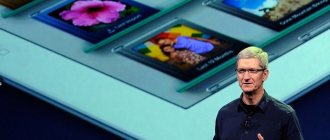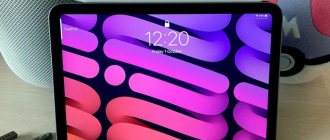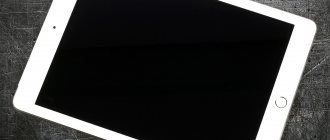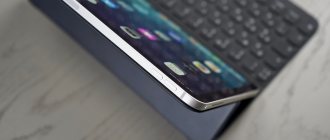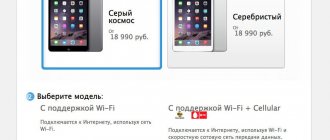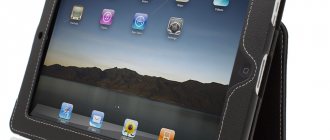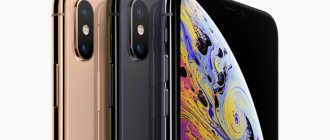Disclaimer: This article was originally published on January 27, 2020.
Big day today.
In 2010, I was one of those who considered the iPad to be just a “bigger iPod Touch” and dismissed the announcement. At the time it seemed logical. The iPod touch was the hottest thing among the people - an affordable ticket to the world of Apple and at the same time one of the most powerful gadgets that could be bought for reasonable money.
After 11 years, there is not a single tablet that can stand on an equal footing with the iPad. Those who are catching up are counted on the fingers of one hand. All the other “killers” disappeared into scandals, failures and oblivion.
Apple essentially created a category, promoted it, updated it year after year and turned it into a device that has no analogues. And its prospects are still ahead.
I have a first generation iPad purchased in the first half of 2010. And the iPad Pro, which I adore. In honor of the memorable date, I decided to compare both - and remind you where the path of Apple's breakthrough gadget began.
Let's feel nostalgic together? Moreover, this is not a standard review, but rather an applied retrospective.
Dawn of the iPad era
The idea of creating an iPad was first voiced in 2000. The world learned the intriguing name of the gadget - “prototype 035”. 4 years later, after intensive work on the design, the external concept of the device appeared before the user’s eyes. As further practice has shown, it became the basis for the implementation of the first generation iPad. Despite the fact that the iPad first became widely sold in 2010, the public was able to see its first pictures back in 2005. The images were made public during legal disputes between Apple and Samsung - as confirmation that the first brand began developing an iPad prototype long before patent rights became available. By the way, the date of the decision coincided with the official launch of the iPad. A competitor of the Apple company paid compensation for the illegal use of ideas.
Design and body. The first one started, the last one returned
The rounded, thick and solid edges of the first iPad migrated to it straight from the Unibody cases of the MacBook Pro. The all-aluminum, silver, one-piece back panel looked advantageous against the background of boring black plastic that filled the store shelves of those times. There was nothing to be confused with the iPad.
The Apple tablet instantly attracted attention, as soon as you took it out of your bag: in 2010, the world had not seen such devices outside of futuristic films and concepts. In reality, this was the effect of the first iPhone. I just heard questions. Wow, what is this, an iPad? How is it, do you like it? Show me what it does. Can I hold it?...
The wow factor was cemented by the huge glass display at a time when clear plastic was considered the norm. In the hands, the device seemed heavy even by 2010 standards (680 grams or 730 grams with a 3G module), but not so much that the hands would fall off after an hour of surfing, watching a video or reading a book.
The design of the iPad became decisive for the entire category of devices in the future, and to this day all other tablets follow it by inertia. It turned out to be difficult to improve something that was almost perfect from the very beginning. The cases became smaller, the frames became thinner, the weight was blown away - but the iPad was and remains unique.
How it's doing today: The hull has stood the test of time. It is almost impossible to critically bend the first iPad. And it’s not easy to break the display with such a high glass thickness. It's easy to do minor damage.
For example, my back panel is worn out from many years of contact with something metal in the closet, and the display is covered with a web of scratches of varying depths.
It's amazing how confidently the tablet takes hits to the frames and the body as a whole. Dents, spots, and at least craters do not prevent the “tank” from working impressively after 11 years. The Home key, volume rocker, silent switch, and lock button work as smoothly as they did in 2010.
If you have this rare device in working condition, try not to break it in 2020, and especially later. There are practically no spare parts left for repairs.
Compare with iPad Pro 2018
iPad 1st generation thickness : 1.3 centimeters. Weight from 680 grams.
2022 iPad Pro thickness : 0.6 centimeters. Weight 468 grams.
11 years of progress have made it possible to reduce the thickness of the iPad by half while increasing productivity by almost a hundred times. At the same time, from the outside, both tablets look more or less similar.
Apple subsequently switched from a convex back panel to a completely flat one, which I personally like much better. Since 2010, aluminum has never left the back panel of all iPads, maintaining the identity of the device against the backdrop of tacky competitors.
Otherwise, both tablets look remarkably similar , which is for the best.
I've always liked the design of the first generation, and the continuity of the most advanced iPad in history is definitely a plus. On topic: First reviews of the iPad Pro 2022. Not everyone liked it
. The only thing in which the iPad Pro 2022 is worse than the very first one is durability. The modern “monster” has so much iron and so little space for metal that some people manage to accidentally, unnoticed, bend the tablet in a backpack or even at home. Mine hasn’t been damaged yet, but getting to the monolithic progenitor of the “proshke” is like walking to the moon.
iPad line: excitement and revolution
Apple was far from the first ideologist to develop a tablet: before that, prototypes of the first tablet computers appeared in science fiction movies and on store shelves. In particular, companies such as ASUS, Sony, HTC, Acer and Nokia tried to implement the idea of a computer with a sensitive screen that does not have a mechanical keyboard. However, all of these devices were bulky, could not boast of particularly wide functionality, and most still needed to connect an additional keyboard. The revolutionary nature of iPads lay in the following features:
- In a slim body;
- There are no extra keys on the device body (only a rocker for volume control, a lock button and a “Home” button);
- In expanded functionality - in addition to the basic functions, already in the first iPads such “goodies” as an accelerometer and a light sensor were introduced (the screen automatically adjusted to the lighting around);
- Starting from the second generation, all iPads had a built-in camera, and a little later a front-facing camera was added to it.
- The new invention supported Wi-Fi and made it possible to connect to the mobile Internet;
- The device had a powerful battery - such a gadget could work for up to 10 hours without recharging.
Interesting read: 10 revolutionary innovations of the iPhone X: what was borrowed from Android and what is truly new
iPad Mini
A smaller version of the tablet appeared in 2012. Interestingly, the characteristics of the new product became known to a wide audience even before its presentation. What contributed to the leak of confidential information. Mini has an 8-inch screen, as well as narrowed side frames, which makes it possible to grasp it with one hand. The remaining characteristics of the gadget are identical to the second generation iPad.
The first generation iPad is a pioneer in the lineup
The first iPad model was shown in early 2010. A significant event took place in the city of San Francisco. The invention was still unfamiliar to the audience and the company incorporated a minimum number of its own ideas into the iPad. Thus, the audience had the opportunity to “touch” the product and evaluate it, and the developers were able to analyze the feedback and understand in which direction they should move next.
Distinctive features of the first generation iPad were:
- Large device thickness: 13 mm;
- Wide side edges;
- Single color composition: black “front” and rear silver panel;
- Weight 680 g.
The model range had two versions of the tablet computer. The first of them supported exclusively Wi-Fi, the second connected via Wi-Fi and 3G. The “stuffing” of the device was enough for Internet surfing, taking notes and communicating on social networks.
| CPU | Memory | Image | Supply system | Dimensions/weight |
| CPU - Apple A4 | Storage capacity - 16, 32 or 64 GB | Screen type: LCD IPS | Lithium Polymer Technology (Li-Pol) | Width - 18.9 cm |
| Processor frequency – 1 GHz | Diagonal - 9.7 inches | Battery capacity - 25 W per hour | Height - 24.2 cm | |
| Screen resolution/format - 1024x768; XGA 4:3 | Battery life - 10 hours | Depth - 1.3 cm | ||
| Features: capacitive | Charging an autonomous source using an external power adapter | Weight - 0.68 kg |
iOS 5 on the first iPad is even embarrassing to compare with iPadOS
Multitasking panel in the first generation iPad with iOS 5.1.1 installed.
The 1st generation iPad came with iOS 3.2 pre-installed. That version of the OS did not have multitasking, which cast a shadow on the functionality of the device. In November 2010, the tablet was immediately updated to iOS 4.2.1, and it literally sparkled with new colors. As well as the brakes, alas.
On topic: Large-scale review of iOS 5
By the release of iOS 5, the iPad became very difficult to use, and Apple stopped supporting the device after iOS 5.1.1. The tablet critically lacked not so much processor power as RAM .
The iPad was simply unlucky: it came out at a time of rapid growth in hardware requirements and the beginning of a significant expansion of iOS capabilities. In 2011, many complained about performance and were in a hurry to move to the iPad 2. I myself saw then how much the App Store overthinks and how Safari suddenly collapses when opening several tabs.
Software support eventually ended just 2 years after the start of sales (the subsequent iPad 2 was supported for 6 years!). Today, to us, accustomed to miracles like the iPhone SE, this will seem nonsense.
How are you today: not very expected. App Store apps have been released without support for iOS 5.1.1 for years, so you won't get anything new on your tablet. Many older versions of games and programs released before 2013 install successfully, but do not work either due to disablement of support for old OS on the server side, or due to critical incompatibility of web standards and iOS 5 technologies.
Many sites that use Javascript (for example, Reddit or iPhones.ru) do not open in Safari or do not load completely. The built-in YouTube app was blocked by Google a long time ago because it was too eager to show you ads. iMessage syncing doesn't work well, but sending them is still possible.
The Kiosk app is long gone, iBooks no longer syncs your iCloud library. Notes from newer Apple devices are not supported on iOS 5.1.1 . The iTunes app is still functional, as is the music player.
The built-in email client stands out: it not only works successfully, but also allows you to confidently read and respond to letters. If the iPad supported Apple Music, there would be a real use case for the tablet. But alas: even the web player doesn’t start, so you won’t be able to listen to the tracks from the service.
Due to the very meager available functionality of the first iPad, I see no point in comparing iOS 4 and iPadOS 2022. The first is only logical to remember (the “skeuomorphic” interface!), wipe away a stingy tear of nostalgia and put it back together with the tablet. The second solves 90% of the work tasks of most people on Earth with lightning speed and even replaces the “desktop” OS for many.
And you know, after half an hour of such nostalgia, I wanted to go back to the iPad Pro with its calm interface. has no place in 2022 .
iPad ll generation - on the wave of fame
The second generation “tablet” was presented twelve months later - on March 3, 2011, in the same San Francisco. And already on May 11, its worldwide implementation began, and the new product “reached” the CIS countries on May 27, 2011.
It is worth noting that during the start of sales, user interest was fueled even by resellers selling their positions in queues for the device (for example, there were stories about prices of up to $800 for a place at the beginning of the queue at the Apple store). In addition, analysts noted that as many as 70% of users bought a tablet for the first time (thereby increasing Apple's share in the technology and innovation sector).
Distinctive features:
- The body part has become more streamlined;
- The sound “moved” to the rear side and was located under the protective perforated grille;
- Before the release of the “airy” iPad Air, the 2nd generation tablet was considered the lightest and thinnest in the line.
Also interesting: 10 best women's smartphones
| CPU | Memory | Image | Supply system | Dimensions/weight | Camera |
| Apple A5 | With RAM capacity of 512 MB | Screen type: LCD IPS | Lithium polymer technology | Width - 18.5 cm | Camera resolution: 0.7 megapixels |
| Processor frequency – 1 GHz | Storage capacity - 16, 32 or 64 GB | Screen diagonal - 9.7 inches | Battery capacity - 25 W per hour | 24.1 cm | Front camera - 0.3 megapixels |
| Screen resolution - 1024x768, screen format - 4:3 | Battery life - up to 10 hours | Depth - 0.9 cm | |||
| Screen Features: Capacitive | Charge from an autonomous source - external power adapter | Weight - 0.6 kg |
Advantages:
- Faster Apple A5 processor (with 512 MB RAM);
- Lively color solution: the silver body remained in place, but the color of the “front” could be chosen between white and black;
- In addition to the main model, Apple released an additional batch of iPad Rev A with a processor modification that allows users to be protected from jailbreak;
- The main, front cameras and a gyroscope appeared.
Flaws:
- The “weak” camera is the main one - 0.7 megapixels, and the front one - 0.3 megapixels.
Implementation ended in the spring of 2012 (for 32 and 64 GB) and in the fall of 2014 (for 16).
Curious to know: What is the difference between a netbook and a laptop: 8 points you didn’t know about
Iron. Apple's total leadership began with the iPad
When Apple launched the iPad in 2010, it included a single-core A4 processor, the most powerful ARM processor in 2010, which moved into the iPhone 4 six months later with minor changes.
The A4 was one and a half to two times more powerful than the iPhone 3Gs processor, and the graphics subsystem performance increased by more than 2 times to ensure efficient system operation while doubling the screen resolution.
The weak point of the tablet was the RAM: 256 megabytes moderately stretched iOS 3, but already on iOS 4 it turned into an Achilles heel.
But at first, the iPad very cheerfully launched all the games from the App Store and even caught the re-releases of GTA 3 and Vice City, as well as the release of Minecraft for iOS. The overall performance of the device was no less pleasing, as long as you didn't try to open a lot of tabs in Safari or use the newfangled multitasking that appeared in iOS 4 too much.
Yes, it's Plague Inc. and it works!
How are you doing today: taking into account such a huge period of time, it’s worthy. Many 1st generation iPads, including those purchased at launch, still work. Performance suffered greatly after the release of iOS 5.1.1, and many applications even from that time were not very responsive. Crashes happen primarily due to lack of RAM .
You can use most of the system's functions without critical problems, including local playback of music and movies through built-in applications.
It’s amazing how durable the iron from 10 years ago turned out to be. The tablet owes this result, among other things, to its thick, legendarily strong body : it is simply statistically predisposed to survive the hardships of many years of use.
By the way, the 2010 iPad supports 5 GHz Wi-Fi networks. Many modern Android smartphones cheaper than 30 thousand rubles still cannot do this.
Compare with iPad Pro 2018
There will be no revelations here. The 8-core A12X Bionic processor in the iPad Pro 2022 is comparable to modern MacBook Pros and still beats all Android smartphones and tablets to this day. And its 6 GB of RAM is almost endless compared to the 256 megabytes of the first iPad.
It was not easy to find a universal benchmark that could measure the performance of two devices with an interval of 11 years. For a long time, Apple has not allowed 32-bit applications for the architecture of older processors to be published in the App Store. Therefore, many benchmarking applications from those times were completely removed from the store (including the first GeekBench).
While looking for an option, I came across the SunSpider 0.9.1 test. This is a test of the execution speed of Javascript code in the WebKit environment of the Safari browser.
Given the huge changes in web standards over 11 years, the test results cannot be called an accurate comparison of tablet power. But they clearly demonstrate how far technology and hardware in devices have come.
▸ iPad 1st generation: 2958.6 milliseconds
▸ iPad Pro 2022: 112.9 milliseconds
According to this test, the 2022 iPad Pro is 26 times faster than the first iPad .
Then we managed to find a free test compatible with the first generation iPad - PerfomanceTest Mobile. It has not been updated much in recent years and is not popular, so its results should also be considered only in the context of curiosity.
▸ iPad 1st generation scored 440 points. The processor was given 4668 points, memory 3217 points, RAM 112 points, 2D rendering 266 points, and 3D rendering 621 points.
▸ 2022 iPad Pro scored 7,300 points. The processor was given 746356 points, memory 244948 points, RAM 31213331 points (looks like a bug), 2D rendering 15895 points, and 3D rendering 1187 points (similarly looks like a bug).
According to this test, the 2022 iPad Pro outperformed the 1st generation iPad processor by 159.9 times, memory by 76 times, RAM by 278,690 times (duh), and 2D rendering by 70 times. The 3D results are clearly wrong, because the iPad Pro 2022 in games shows results that exceed the theoretical performance of the first iPad by tens of times.
A huge leap has been made in 11 years. Apple began to lead the mobile processor category with the A4, and its continued focus on creating its own chip architecture made possible the iPad Pro 2022 - thinner, lighter and more powerful than many modern laptops.
III generation iPad (or The New iPad)
Another variation - this time the 3rd in a row - was “born” on March 7, 2012. In this version, Apple decided to move away from numbering devices and thought that it would be more logical to give them names. According to the official statement, this was done to avoid associations among users “the higher the number, the better the product.” Trading started two months later - on May 16; the gadget “arrived” in the CIS at the end of the same month.
| CPU | Memory | Image | Supply system | Dimensions/weight | Camera |
| Apple A5X CPU | RAM capacity - 1024 MB | Screen diagonal - 9.7 inches | Battery life - up to 10 hours | Width - 18.5 cm | Resolution - 5 megapixels, front - VGA |
| Processor frequency – 1 GHz | Storage capacity - 16, 32 or 64 GB | Screen resolution - 2048x1536, screen format: QXGA - 4:3 | Height - 24.1 cm | ||
| Screen Features - Capacitive | Depth - 0.94 cm | ||||
| Weight - 0.6 kg |
Read at your leisure: How to choose a laptop: 12 tips Advantages:
- Retina display with a resolution of 1536x2048 pixels/inch.
- Saturation (largely thanks to the updated screen) increased by as much as 44%.
- Ability to create videos in Full HD.
- The new device now has the ability to use 3G.
- The new tablet has “learned” to recognize faces during video shooting, and additional sensors have been installed to stabilize the image.
- The appearance of Siri (an assistant controlled by the owner’s voice) and the ability to dictate text.
- 64 gigabytes (in addition to the usual 16 and 32 GB).
Date withdrawn from sale: November 2012.
iPad 2 (2011)
- Screen - 9.7 inches;
- Processor - Apple A5;
- Memory: 16, 32, 64 GB;
- Colors: silver back, black or white front;
- Model numbers: A1395 (Wi-Fi), A1396 (Wi-Fi + Cellular), A1397 (Wi-Fi + CDMA).
So, even for the level of technology development at the end of 2010, the first Apple tablet was not impressive with its characteristics, to put it mildly. But already in March 2011, Apple introduced a new version of the iPad, in the description of which you can find many “2” numbers. The iPad 2 processor became 2-core, 2 times more RAM was installed (512 MB), and 2 cameras appeared at once with a resolution of 0.3 and 0.7 megapixels. In addition, Cellular models now supported the more popular MicroSIM cards, instead of the bulky standard ones.
In 2012, Apple also released a modified version of the iPad 2 with increased battery life, which was achieved through an improved Apple A5 processor (manufactured using a 32nm process) and a larger battery.
IV generation (or iPad with Retina Display)
The 4th iPad from the line was shown to the world in San Jose in 2012 (October 23). Basically, this variation of the tablet turned out to be a modified variation of the previous, “third” model.
Distinctive features:
- “Pumped up” Lightning USB connector.
- Implementation of three representatives of the line: WiFi model, “American” and Cellular. The difference between all three was the support of different LTE network bands.
- Memory has been upgraded to a maximum capacity of 128 GB.
| CPU | Memory | Image | Supply system | Dimensions/weight | Camera |
| CPU – Apple A6X | RAM capacity - 1024 MB | Screen diagonal - 9.7 inches | Battery life up to 10 continuous hours | Device width - 18.5 cm | 5 megapixel camera, |
| front - 1.2 megapixels | |||||
| Processor frequency – 1.4 GHz | Storage capacity - 128 GB | Resolution and screen format - 2048x1536; QXGA 4:3 | Height - 21.4 cm | ||
| Screen Features: Capacitive | Depth - 0.94 cm | ||||
| 0.662 kg |
Advantages:
- The A6X processor was integrated into the “fourth” version of the tablet (4 graphics cores, significantly surpassing the 5 series in power);
- Can work without recharging for up to 11 hours;
- Availability of AirDrop;
- Frontal shooting in HD.
Sales were completed in November 2013. Later (March 18, 2014), it was decided to return the device to store shelves.
Interesting to know: Apple Iphone 8, Iphone 8 Plus And Iphone X: what you need to know about the new products, where you can buy them and what the price of smartphones is
iPad 4 (late 2012)
- Screen - 9.7 inches;
- Processor - Apple A6X;
- Memory: 16, 32, 64, 128 GB;
- Colors: silver back, black or white front;
- Model numbers: A1458 (Wi-Fi), A1459 (Wi-Fi + Cellular), A1460 (Wi-Fi + Cellular, MM (multi-mode))
Six months later, in October 2012, another update awaited the line of Apple tablets. The main thing, from the point of view of the evolution of the model range, was the appearance in the new iPad of an 8-pin Lightning port (previously a wide 30-pin port was used), which is used to charge and synchronize iOS devices to this day. In addition, the iPad 4 was equipped with a faster Apple A6X processor and PowerVR SGX554MP4 graphics core, and also installed a front FaceTime camera with a 1.2 megapixel matrix. In February 2013, the iPad 4 with a built-in memory of 128 GB went on sale.
iPad Air - weightlessness of your favorite gadget
After the success of the classic iPad, the company chose to create a lightweight copy of its acclaimed first-born, the iPad Air. The public got acquainted with the device on October 22, 2013, at the Center for Contemporary Arts (San Francisco) under the slogan “We still have a lot to tell.” The public immediately fell in love with “zero gravity,” and within four weeks the iPad Air began to account for 3% of sales of all Apple tablets.
The distinctive features of the new product are:
- Narrower screen frames;
- Changed parameters: the total length of the gadget decreased by 3 mm, thickness by 5.5 mm, and width by 20.5 mm;
- There are now two stereo speakers on the back of the device;
- The device included one microphone built into the body;
- The keys for switching the volume in the “air” tablet began to be divided into 2 halves.
Read at your leisure: Review of Apple's most budget tablet. Apple iPad 9.7 (2017)
| CPU | Memory | Image | Supply system | Dimensions/weight | Camera |
| CPU – Cortex A8X | 16, 32, 64 and 128 GB of storage capacity | Screen diagonal - 9.7 inches | Up to 10 hours of battery life | Width - 16.9 cm | 5 megapixels, front - 1.2 megapixels |
| Processor frequency – 1.3 GHz | Resolution and screen format - 2048x1536; QXGA 4:3 | Height - 24 cm | |||
| Screen Features - Capacitive | Depth - 0.75 cm | ||||
| Weight - 0.478 kg |
Advantages:
- There were again three communication variations: representatives with Wi-Fi, LTE and TD-LTE (which was specially added for users in Southeast Asia).
- Thanks to the Apple A7 processor, as well as the M7 co-processor, the device’s performance has increased several times.
- Two colors became available to users: classic silver and “space” gray.
- There are 4 options for user memory to choose from: 16, 32, 64 and, respectively, 128 GB.
Flaws:
- The camera, compared to its “ancestors,” remained at the same stage of development;
- Speakers with mono sound.
The end of sales for the 64 and 128 GB models came in October 2014.
Read also: ANDROID AND iOS: 6 options borrowed from each other
iPad 3 (early 2012)
- Screen - 9.7 inches;
- Processor - Apple A5X;
- Memory: 16, 32, 64 GB;
- Colors: silver back, black or white front;
- Model numbers: A1416 (Wi-Fi), A1430 (Wi-Fi + Cellular), A1403 (Wi-Fi + Cellular, Verizon subscribers only)
The main innovation of the iPad 3 was the Retina display with a resolution of 2048 × 1536 pixels, which provided twice the picture quality - 264 pixels per square inch versus 132 pixels in previous models. In addition, instead of the useless 0.7-megapixel main camera, the iPad 3 was equipped with a competitive iSight optical module with a 5-megapixel matrix. The Apple A5X processor had the same two cores and a clock frequency of 1 GHz, but the capacity of the RAM module was doubled again, to 1 GB.
iPad Air 2: even more convenient
The new iPad Air was shown to the public on October 16, 2014. The acquaintance with the “new blood” took place at the Yerba Buena Center, already familiar to the San Francisco audience. The smallest tablet apple began to be sold on October 24, 2014.
Distinctive features of the updated device:
- Reduction in thickness by 1.4 mm (in the new device the figure was 6.1 mm);
- The Wi-Fi version stopped at 437 grams, and the LTE tablet weighed 444 grams.
Interesting read: 10 laptops with the most powerful battery: how to choose the best one?
| CPU | Memory | Image | Supply system | Dimensions/weight | Camera |
| Apple A7 1400 MHz | RAM – 1 GB | Screen diagonal - 9.7 inches | Battery capacity - 8827 mAh | Length - 240 mm | Main camera - 5 megapixels |
| Number of cores - 2 | Resolution - 2048x1536 | Ability to charge the tablet using USB | Width - 170 mm | Front camera - 1.2 megapixels | |
| Pixels per inch - 264 | |||||
| Screen type: TFT IPS, glossy, scratch-resistant glass | Battery life - up to 10 hours | Depth - 8 mm | The main camera has autofocus capabilities | ||
| Capacitive screen, multi-touch | Weight - 469 g |
Advantages:
- In this model, we managed to make the graphic display work twice as well, and increase the CPU parameters by as much as 40%. All this was achieved thanks to the new A8X processor.
- The M8 coprocessor became responsible for the operation of the barometer, motion control and sensor calibration.
- For the first time, Apple tablets have integrated the Touch ID fingerprint recognition system.
- You can now use Apple Pay.
- In addition, the camera has been improved: 8 megapixels, capable of shooting in timelapse and slow motion modes. In addition, the new camera can burst out several photos at a time.
- The color options have also been updated: a model in a gold case is now available to users.
Flaws:
- For the first time, Apple did not release a tablet model with 32 GB of memory.
iPad 2
The second generation iPad was introduced in the spring of 2011. The new product began to weigh less and lost thickness, and the processor was replaced with a dual-core one, although the frequency remained the same. However, the most important innovations are the rear and front cameras. The second iPad was produced until February 2014, and the iOS installed on it can still be updated to the eighth version.
iPad 2022: balance of price and functionality
As a rule, users associate Apple technology with something very technological, innovative and very expensive. But every rule must have its exception - in the case of iPads, the 2022 model (presented on March 21) became such an exception. This gadget has preserved everything that is necessary for the life and work of a modern person - simply and tastefully, without unnecessary high-tech bells and whistles. In essence, the model was a relaunch of the iPad Air, but in a more modernized and budget format.
This tablet will fit well with the average user who needs a high-quality and reliable machine to solve ordinary problems.
Distinctive features:
- Updated processor;
- Improved operating system;
- Large battery capacity.
| CPU | Memory | Image | Supply system | Dimensions/weight | Camera |
| Apple A9 | Memory RAM 2GB | 9.7 inches | Battery type Li-Ion | Height 240 mm | Main camera – 8 megapixels |
| Built-in memory 32, 128 GB | Resolution 1536 x 2048 pixels | Battery capacity 8827 mAh | Width 169.5 mm | Autofocus available | |
| Pixel density 264 pixels | Talk mode - work up to 10 hours | Thickness 7.5 mm | Front camera - 1.2 megapixels | ||
| Protection. Scratch-resistant glass, oleophobic coating. Multitouch | Weight 478 g |
Advantages:
- Touch ID fingerprint scanner;
- The device was awarded with an innovative A9 processor and two gigabytes of RAM, which made the device even more nimble.
Flaws:
- Pencil and other styluses do not work with this tablet;
- Does not support smart keyboard;
- The device does not have a slot for a memory card - during operation it is possible to use only the built-in capabilities (32 or 128 gigabytes).
Also interesting to know: iPhone 8: parameters and nuances
iPad 5 (2017)
- Screen - 9.7 inches;
- Processor - Apple A9;
- Memory: 32 and 128 GB;
- Colors: silver, gold or space gray back, black or white front;
- Model numbers: A1822 (Wi-Fi), A1823 (Wi-Fi + Cellular).
In March 2022, Apple again diversified its tablet lineup by offering a lower-cost option for users who don't need the iPad Pro's features. The 9.7-inch gadget received a rather modest display matrix with a resolution of 2048 × 1536 (like the first generation iPad Air), an Apple A9 processor (without the “X”), and an 8-megapixel main camera. At the same time, the device has added in size and weight when compared with the iPad Air 2.
iPad 2022: updating your favorite tablet
The iPad 2022 update did not take long to arrive: just a year later, the public receives the 9.7-inch 2022 version. Despite the fact that the dimensions and price of the device have remained almost the same, in some aspects the device has undergone significant updates and changes.
Distinctive features of the gadget:
- Four stereo speakers on the bottom of the camera produce loud and clear sound;
- Mechanical “Home” button;
- This tablet has a first-generation sensor for reading the owner’s fingerprint - a kind of “anti-theft.”
Characteristics:
| CPU | Memory | Image | Supply system | Dimensions/weight |
| CPU – Apple A10 Fusion | 2 GB RAM | Screen type: LCD IPS | Lithium Polymer Technology (Li-Pol) | Width - 240 mm |
| 4 cores | Diagonal - 9.7 inches | Battery capacity - 32.4 W/hour | Height - 169 mm | |
| Built-in M10 processor | Screen resolution/format - 2048x1536 | Battery life - 10 hours | Depth - 7.5 mm | |
| Weight - 469 g |
Advantages:
- Availability;
- Good image quality;
- Metal body;
- The model is compatible with accessories for previous Apple tablets;
- Performance: works for a long time both during battery operation and when “surfing” the Internet.
Flaws:
- There are practically no changes compared to its predecessors;
- High price for the Apple Pencil stylus.
iPad 6 (2018)
- Screen - 9.7 inches;
- Processor – Apple A10 Fusion;
- Memory: 32 and 128 GB;
- Colors: silver, gold or space gray back, black or white front;
- Model numbers: A1893 (Wi-Fi), A1954 (Wi-Fi + Cellular).
A year after the release of the fifth generation iPad, Apple made a minor update to the device, mainly related to performance. Visually, the tablet has not changed at all, but it has received a new Apple A10 Fusion processor, an M19 Motion co-processor and updated graphics.
iPad Mini line
The announcement of the Apple iPad Mini provoked a mixed reaction among the public. The main prerequisite for skeptical views were statements by the company itself, which previously claimed that “tablets” with a small diagonal are inconvenient and not entirely suitable for full, comfortable use. However, a mini version of the popular iPad was created and presented. Despite some “compressed” characteristics (the first mini-iPads, for example, did not have retina glass), the compact version became popular and almost immediately found its fans. The main advantages of the line were, of course, the modest dimensions, as well as the relatively inexpensive cost of the models.
iPad Mini: always with you
A small copy of the popular iPad was first introduced to the public on October 23, 2013 in San Jose. In general, the iPad Mini is a small iPad 2: the device is endowed with almost all the characteristics of its older brother.
Distinctive features:
- Narrower frames around the display (compared to earlier representatives);
- The entire gadget is made entirely in one color;
- Volume control buttons were presented as separate keys for the first time.
Advantages:
- Lightning port;
- 4G module;
- Advanced selfie camera;
- 8 or more hours of work with relatively modest initial data.
Display. It was decent then, but now it’s magical
When the iPad launched in 2010, a display of this caliber was hard to come by. Color reproduction was very commendable, viewing angles were unusually impressive (iPhone 4 came later), and the resolution of 1024x768 was normal.
It was one of the few gadgets with an IPS screen, and next to the smartphones of those times (and laptops too), it looked very advantageous, especially at an angle.
Not the highest resolution at that time bothered anyone. Apple has tried to make fonts and small details look as clear as possible and not strain the eyes.
Some people wrote down the thickness of the frames as a minus, but objectively at that time there was nothing to criticize the tablet for. Considering the heavy weight, such frames turned out to be very useful. The tablet had to be held much stronger and more confidently in the hands than, say, the much lighter iPad Pro 2022.
How are you doing today: varies. If you actively used the first iPad for at least a third of the past 11 years, its display began to slowly leak. Lights and spots have appeared, indicating the consumption of the display resource. Nothing lasts forever.
The completely damaged screen of this iPad is difficult to replace not only because of the design features (there is a lot of glue inside), but also because of the lack of spare parts themselves. So if everything is OK with your model, take care of the display.
Compare with iPad Pro 2018
Both are at maximum brightness.
Just look at this photo, and everything is clear without words.
Time tells when you put next to the simply incredible iPad Pro 2022 with its juicy, bright, laminated Super Retina screen (above 2K resolution). Absolutely all display parameters, from viewing angles to contrast, in the new firmware are amazing even in comparison with other gadgets of recent years.
The frames have become more than 2 times thinner , and the screen itself has become more than an inch larger. At the same time, the body also shrank.
And you also say that progress stands still. Yes, these two displays are like from different universes. And many people were delighted with the fact that the first iPad had it when it came out.
iPad mini with Retina display
It was shown to the public on October 22, 2013.
A distinctive feature: a fresh color scheme for the rear panel called “Space Gray”.
| CPU | Memory | Image | Supply system | Dimensions/weight | Camera |
| CPU – Apple A7 | Storage capacity – up to 128 GB | Screen diagonal - 7.9 inches | Up to 10 hours of battery life | Width - 13.4 cm | Camera resolution - 5 megapixels, front - 1.2 megapixels |
| Processor frequency – 1.3 GHz | Resolution and screen format – 2048 x 1536 QXGA 4:3 | Height - 20 cm | |||
| Screen type - capacitive | Depth - 0.75 cm | ||||
| Weight - 0.314 kg |
Advantages:
- Thanks to the “retina”, the picture has become much better quality;
- The top-end variation of this iPad was equipped with a large memory - 128 Gigabytes, which could already be compared with an “adult” iPad.
Read interesting: 10 best ASUS smartphones
Battery. 11 years 10 hours of work
I remember how much people were captivated by this feature of the first iPad. Many didn't believe it at all. 10 hours of battery life at that time seemed an unrealistic figure for a mobile device with such a large screen.
Apple set the highest bar for battery life, which not only tablets of that time - even computers could not reach. With continuous video playback, the first iPad managed to work for more than 12 hours , 4 times longer than laptops or portable DVD players. Under load – 9 hours.
Since then, every iPad, including mini and Air, has conformed to this gold standard. Competitors tried to catch up with it for several years, and then practically died out with the total failure of tablet computers not based on iOS. Meanwhile, the 2022 10.5-inch iPad easily lasts 13-14 hours .
The legendary long battery life has helped the iPad find many niches of use: flights, trips, work in the field. A thin device with a large screen that you can rely on - 3 years before the announcement of the iPad, this seemed impossible.
The battery is almost 10 years old.
How are things today: even taking into account the natural degradation of cells, the 1st generation iPad manages to maintain from 5 to 8 and a half hours of battery life. The duration depends on the operating conditions of the tablet. Many users put the first iPad in a drawer after the release of the iPad 2 or a little later, sometimes remembering and recharging it.
Therefore, many of the devices entered 2022 with a very durable battery. Certainly more lively than most Android tablets. I have a couple of these “buckets”, one does not turn on without a cable, the second lasts 40 minutes. Both are less than four years old.
I can only advise owners of the 1st generation iPad: make sure that the battery does not swell. No matter how capacious it may be, physics and chemistry are inexorable. If you notice that the display or case has swollen a little - recycle it, don’t wait for the depletion of the resource to end with pops and smoke.
Compare with iPad Pro 2018
Data taken from CoconutBattery app.
The 2010 iPad's battery is 6600 mAh . With half the thickness of the case, the iPad Pro 2022 fits a larger battery: 7812 mAh , and for some reason mine has as much as 8132 mAh . There is progress.
The iPad Pro 2022 can work for those “golden” 10 hours, this is not a problem for it. But the device is obscenely powerful, with a thin body and a high-resolution display. This means that its power consumption significantly eclipses that of a tablet from 10 years ago.
While testing the iPad Pro as a laptop replacement, I discovered a specific “life hack”. If the screen brightness is set to or above 60%, the operating time drops by a third. It’s worth lowering the brightness slider to at least 40%, and battery life increases before your eyes. Apparently, the display backlight in this model is very energy-consuming.
With a moderate load and low brightness, the 11-inch iPad Pro lasts for me the same 9-10 hours, and when reading books at low brightness it easily lasts 11 hours. In games or CPU-heavy tasks it will take 5-8 hours.
So Apple is keeping its unspoken promise to this day. And it’s not entirely correct to compare tablets directly: the range of capabilities and functionality of the first iPad is scanty compared to the iPad Pro. It's like complaining about the gas mileage of a sports car and contrasting it with a lawnmower. No offense, just let's face reality.
iPad Mini 3: the perfection of your favorite model
After the 2nd “Mini”, the line gained very good popularity, which “hurried” the creation of the third mini-generation just a year after the release of its predecessor.
Key Features:
- The main color palette includes a gold color for the body;
- A small transformation in details: the color surrounding the Home key has changed, which is now the same shade as the body.
| CPU | Memory | Image | Supply system | Dimensions/weight | Camera |
| CPU – Apple A7 | RAM – 1 GB | Screen resolution - 2048x1536 | 10 hours of battery life | Length - 200 mm | Main camera - 5 megapixels |
| Retina display, Screen type - TFT IPS, glossy | USB rechargeable | Width - 134.7 mm | Front camera - 1.2 megapixels | ||
| Screen diagonal - 7.87 inches, Pixels per inch - 325 | Depth - 7.5 mm | Main camera with autofocus capability | |||
| Scratch-resistant glass, multi-touch | Weight - 331 g |
Advantages:
- Stronger processor.
Flaws:
- There is no 32 GB option.
Interesting read: TOP 10 best business class smartphones
Air
Presented in the fall of 2013, the new flagship iPad received the Air prefix, with which Apple emphasized the thinness and lightness of its new mobile device. Compared to the previous generation tablet, it has become almost 30% lighter, losing 16.2 millimeters in thickness.
The key change for this iPad was the use of the latest processor with 64-bit architecture. However, the amount of RAM has not increased. As before, it amounted to 1 GB.
iPad Mini 4: power in a compact size
This “baby” was presented by Apple on September 9, 2015.
Main advantages and differences from earlier models:
- Stronger hardware: this tablet is equipped with two Gigabytes of RAM, an Apple A8 processor, as well as an M8 coprocessor;
- The silent and lock mode switch has moved from the device directly to the Control Panel;
- Accelerated shooting has appeared, now allowing you to shoot video at a frame rate of 120 fps;
- The battery capacity was 5124 mAh (while predecessors could offer 6471 mAh). However, this did not affect the operating time in any way: thanks to low power consumption, the device can also be used for up to ten hours;
- The new PowerVR GX6450 graphics processor made it possible not only to watch videos in good quality, but to “drive” modern games.
| CPU | Memory | Image | Supply system | Dimensions/weight | Camera |
| Apple A8 processor | RAM – 2 GB | Screen type - TFT IPS, glossy | 10 hours of battery life | Length - 203.2 mm | Main camera – 8 megapixels |
| Apple M8 coprocessor | Screen diagonal - 7.85 inches, pixels per inch - 326 | Width - 135 mm | Front camera - 1.2 megapixels | ||
| Screen resolution - 2048x1536 | Depth - 6.1 mm | Main camera autofocus capability | |||
| Touch capacitive screen, multi-touch | Weight - 304 g |
Flaws:
- The thickness of the device has dropped to 6.1 mm, making it impossible to connect older accessories.
iPad Pro line
The “professional” line of tablets from Apple was intended not only to diversify the model range, but also to attract the attention of those users who want to spend not only their leisure time, but also their working time with the gadget. The Pro line models have more powerful hardware, which, for example, allows you to run two applications on the tablet screen simultaneously. Even watching movies on it is more interesting - all thanks to 4 speakers and stereo sound. In addition, working with this line is really convenient and pleasant: this is facilitated by the device’s increased RAM, the largest diagonal and the Apple Pencil stylus. And additional ports allow you not only to connect other devices, but also to use a portable keyboard - thus turning the tablet into a real portable computer. Thus, the iPad Pro will suit many: from office workers to artists, because in addition to practicality and “company”, it is also a really good work equipment, designed for a variety of tasks.
iPad Pro 11 inches (2018)
- Screen - 11 inches;
- Processor – Apple A12X Bionic;
- Memory: 64, 256, 512 GB and 1 TB;
- Colors: silver or dark gray back panel, black front panel;
- Model numbers: A1980 (Wi-Fi), A2013 and A1934 (Wi-Fi + Cellular), A1979 (Wi-Fi + Cellular, Chinese market).
Once again, Apple engineers demonstrated their ability to save space - with an 11-inch Liquid Retina screen with a resolution of 2388 × 1688 pixels, the new tablet fits into the body of the previous 10.5-inch model, and even became a little thinner and lighter.
At the same time, the gadget was equipped with a top-end 8-core Apple A12X Bionic processor, Face ID facial recognition technology (TrueDepth, Portrait Mode, Animoji and Memoji) and a USB-C port for charging. Separately, it is worth noting the appearance of a version with a 1 TB drive.
First generation iPad - Pro 12.9
Another iPad, named not by number, but by diagonal, was announced by the company on September 9, 2015.
Distinctive features and advantages:
- Maximum display resolution: 2732x2948 at 12.9”;
- On the left there was an additional port through which you can connect an external keyboard - with it the device could be used as a small computer;
- The RAM has also improved - the Pro version received 4 GB of RAM and a 2.26 gigahertz processor;
- With the new model it is now possible to use the Pencil stylus;
- A mode for running two applications in parallel on the display is available.
Flaws:
- The cameras are only 8 and 1.2 megapixels.
| CPU | Memory | Image | Supply system | Dimensions/weight | Camera |
| Main processor – Apple A9X | 128 GB internal memory | Screen resolution - 2732x2048 | The battery allows you to work up to 10 hours without recharging | Length - 203.2 mm | Main camera – 8 megapixels |
| Diagonal - 12.9 inches | Battery capacity - 38.5 Wh | Width - 135 mm | Front camera - 1.2 megapixels | ||
| Scratch-resistant glass | It can be recharged via USB | Depth - 6.1 mm | |||
| Screen type - TFT IPS, glossy | Weight - 268 g |
Interesting to know: TOP 10 best MOTOROLA smartphones
iPad Pro 10.5 inches (2017)
- Screen - 10.5 inches;
- Processor - Apple A9X;
- Memory: 64, 256 and 512 GB;
- Colors: silver, gold back or space grey, rose gold, black or white front;
- Model numbers: A1701 (Wi-Fi), A1709 (Wi-Fi + Cellular), A1852 (Wi-Fi + Cellular, Chinese market).
Apple engineers managed to fit the 10.5-inch iPad Pro into a body comparable in size to the iPad Pro 9.7, while equipping the device with the top-end 6-core Apple A9X processor, manufactured using a 10-nanometer process technology. In addition, ProMotion technology was introduced into the tablet, allowing it to achieve a display refresh rate of 120 Hz.
II generation: iPad Pro 9.7
The updated firmware was presented to the public on March 21, 2016.
Advantages and distinctive features:
- 12 MP photo. A flash appeared. Front camera 5 megapixels;
- Adjustability of the display color scheme depending on the light intensity;
- The most complete firmware in the series has as many as 2 gigs of RAM, a processor with 2 cores, and an IPS matrix for more natural color reproduction.
Otherwise, almost nothing has changed: the tablet can still run two applications simultaneously, offers 4 speakers for stereo sound and the ability to connect a keyboard.
Curious to know: 10 best phablets (smartphones with a large screen)
| CPU | Memory | Image | Supply system | Dimensions/weight | Camera |
| dual core Apple A9X | Choice of: 32, 128, 256 GB of internal memory | 9.7 inches | 7306 mAh. | Length - 240 mm | main – 12 megapixels |
| processor clock frequency - 2.26 GHz | RAM: 2 GB | 2048 x 1536 pixels | Width - 169.5 mm | front - 5 megapixels | |
| 264 PPI | Depth - 6.1 mm | ||||
| Weight - 444 grams |
What to look for when choosing a tablet
When choosing a new iPad, you should focus on the main factors:
- Purpose of use - if the tablet is needed for simple purposes (for example, watching movies) - models with a large diagonal and good color reproduction are suitable. To read books, you can purchase a model from the mini line - it will be convenient to take with you due to its small size and weight. Models with a good processor that can withstand heavy loads without problems are suitable for work;
- Gadget price;
- Dimension;
- Technical features.
Before buying a new mini-computer, you need to thoroughly study all these points, which will help you choose not only a high-quality, but also a truly convenient tablet for a long time of service.
